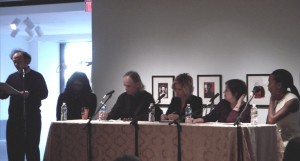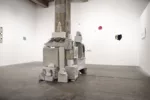I sat in my seat shaking.
What was titled, “Public Forum on Gender and Race in Contemporary Art,” at the Pennsylvania Academy of Fine Arts on Sunday, February 20th, primarily became a discussion on the role, and, perhaps, responsibility of the art critic today, specifically in regards to identity-based art.

The forum was also an unofficial public critique of Ken Johnson, The New York Times art-critic whose 200-word preview of PAFA’s current exhibition The Female Gaze and longer review of Now Dig This! Art & Black Los Angeles 1960-1980 received a formal petition, (later identified as an open letter), asking the Times to acknowledge Johnson’s use of ill-informed arguments, replaying of stereotypes in the guise of inquiry, and lapse in editorial standards.
For those unaware of the controversy, I send you to three links: the preview, the review, and the petition.
As an art critic, do I think the precise phrasing Ken Johnson used in his reviews was ideal – absolutely not. His intentionally provocative choice of words got him in trouble. But his framing of The Female Gaze in the scope of the male-dominated art market, however provocative, was not malicious. His words reflect reality, not prejudiced opinions in support of this reality’s existence.
I thought the same thing Ken Johnson did about The Female Gaze. (I did not see Now Dig This!). The first room dedicated to self-portraiture was wonderful and a handful of individual pieces sprinkled throughout the rest of the exhibition were remarkable. But other than representing a long list of women artists’ names from one woman’s collection, the show did nothing to advance the female artist. Perhaps it celebrated, but in a manner that was not progressive. I left the show disappointed, feeling like the predominately male-made stereotypes of women artists had been reinforced, rather than challenged.
But my intention in this piece is not to focus on the controversy itself, but rather on the two-hour conversation that took place Sunday evening.
The panel’s composition was unfair from the beginning: four women against Johnson. Panelists included Kimberly Brooks, Huffington Post art editor, and artists Njideka Akunyili and Joyce Kozloff. Gwendolyn DuBois Shaw, University of Pennsylvania Associate Professor of American Art, moderated the forum. The diverse, packed audience also seemed ready to fight, leaving Ken Johnson an isolated target.
The forum mostly consisted of Shaw posing general questions about contemporary art criticism to the panelists. Brooks, (clearly the crowd favorite), played the instigator as Johnson was presented as an aging critic who undoubtedly favors the white-male artist, since he himself is a white male. As the evening progressed, Johnson’s tone became more and more aggravated.
The writer’s identity became the reoccurring question of the forum. If the background of the critic is essential, then perhaps you must now know mine: female, white, 24. But how far does one need to reach? Must you know that I was raised in the Midwest? That I am the daughter of a newspaper editor and historic preservationist? Do you need to know that the newspaper editor was my mother and the preservationist my father? That my mother is a feminist? That I am a feminist?
And even if you learn these details would you still box me into the category of a young, white female? What happens for my writing if you, the audience, know that I grew up in a largely black community or that I lived in El Salvador? How much of my identity must my audience know to respect my words, my opinions, on art? And how much of my identity – in this case, my age – can be used against my words?
Johnson’s identity does matter – as does mine – but the words and the dialogues we produce matter more.
To their credit, the panelists offered some insight. Akunyili stressed the importance of conversation and the continued need for art criticism today. Brooks brought up the evolving field of art journalism, particularly in respect to blogging culture. And all three panelists discussed their identity as women artists and what that means in presenting their work in all women shows. There were sparks of substance, but nothing ever ignited, leaving these compelling thoughts in abstraction rather than ever getting to the heart of why we were all there.
One of the first questions posed to Johnson from the floor asked why he could not just state the facts and leave his opinions out. I almost fell to the floor: a plea for objectivity in art criticism.
As an editorial writer, my mother chose not to participate in any political function in the city of St. Louis. She had to perform objectivity daily for her work to be accepted as legitimate. As an art critic, it is my job – and Ken Johnson’s job – to go out to see art. If I do not engage with works and spaces, speak with artists and curators, or offer my subjective views and interpretations of social occurrences, then, as a citizen, I am not adequately engaging with art and, as a critic, successfully performing my job. As Ken Johnson said Sunday night, “We get to translate our experiences of the visual into language. It is a magical task.”
The idea of an objective, formalist art critic is preposterous.
Another echo throughout the evening was the call for more historical background in exhibition reviews – essentially asking for more art history in journalism. Johnson responded fairly: there are already appropriate spaces for that – art historical journals, catalogues, books. While providing a historical background is certainly necessary, it is not the preeminent task of the critic.
Instead, it is about starting a conversation, providing, in a limited word count, the who, what, when, where, and how with a subjective reading of a show’s success. By no means are the writer’s words the last words. If anything, they are the initial entryway into a conversation, a push for the public to engage with the art and to respond in whatever magical way it is for her or him.
Another audience question (and I paraphrase): Shouldn’t art with histories, such as feminist art or black art, be treated more sensitively.
My shaking escalated: All art comes with a history.
Minimalism has a history. Salvadoran folk art has a history. And histories cannot be privileged. The histories of feminist art or black art cannot be favored over the histories of revolutionary mural painting, Native American art, or art critiquing the technological age. Histories themselves have histories that are innately composed of memories and rooted in subjective experiences.
Art is one of the most powerful ways of giving voice to the memories that have been marginalized, suppressed, or forgotten. We must insure that histories are accurate, complete, and persistently returned to and that artists who have been written out of the history books, such as those represented in The Female Gaze and Now Dig This, receive recognition, representation, and remembrance. But we do not have the right to determine hierarchies of marginalization when histories themselves are innately interwoven.
Returning to the responsibility of the art critic, it is imperative that the writer presents the facts as he or she knows and understands them. Correctness is essential. Ken Johnson was not incorrect, but his comments did push that line. In Now Dig This, he presented another history of a history, actively choosing to provoke the public’s interpretations. And because of that choice we are now talking.
A final overlying tension of the forum was the generational divide for many identity-based artists, particularly regarding feminism. My mind kept returning to statements from artist Carolee Scheenemann during a UPENN master class last spring. As an art student in the late 1950s-60s, she never had a female professor and was told by a male art instructor at Bard College (my alma-mater): “You’re really gifted kid, but don’t set your heart on art. You are only a girl.”
And yet speaking about the contemporary art world, she acknowledged a remarkable change. “When you look at the reviews in the Times,” she said, “At least half of them or even more are women and I am beginning to wonder: Where are the guys now?”
By no means have we reached an age of gender equality in the arts. There are still many histories that have not been represented and institutional acknowledgements that must be had. But the elephant in the room Sunday evening was this generational divide in contemporary art among female artists. For many, gender is still everything. And yet for some, including myself, gender is often irrelevant in our work – despite the fact that we carry these histories. I did not have to fight – and I thank my mother, Carolee Scheenemann, and many of the artists represented in The Female Gaze for that. But I also wonder what questions we are still avoiding, what fights, such as economic divides, are being suppressed, and what my gender, if anything, will signify moving forward.
This is the needed conversation that Ken Johnson provoked. But we didn’t get there Sunday night. Instead we fell back on old clichés, pointing the blame at the art critic rather than writing open letters to the art institutions, foundations, collectors and dealers who predominately back these white male artists.
The conversation had the opportunity to be a great one – and Ken Johnson seemed ready to have it. But the night failed us all leaving these critical questions unanswered. Rather than moving forward, it was a step back into the discourses we have already had and the histories we have already written.
The fact that so many gave up their Sunday evening to listen and engage is proof that artists, the public, and cultural practitioners are eager to discuss where race and gender are going in contemporary art. We really must try that conversation again.









